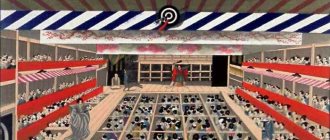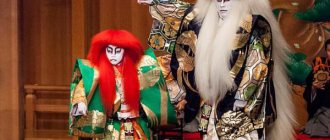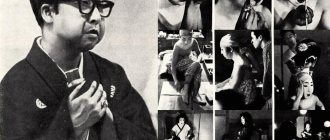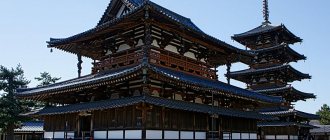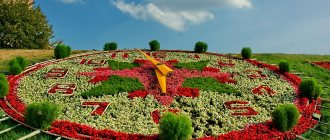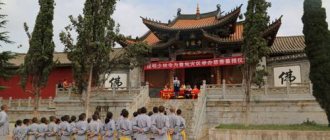It is believed that the history of Kabuki theater begins with the Kabuki-odori
, which were performed by the dancer Izumo no Okuni in 1603. Over the past more than 400 years of Kabuki's existence, the history of the theater spaces where plays were performed has been rich in changes. The exhibition "Kabuki: Theaters of the Edo Period", held from February 6 to March 31, 2013 at the Suntory Art Museum (Tokyo, Roppongi), was dedicated to the history of the theatrical space. The exhibition featured paintings depicting theaters and actors, theater plans, and everything that reflected the changes taking place with the Kabuki theater, a favorite entertainment of the townspeople.
Fragment of a pictorial scroll from the early 17th century depicting the performance of Izumo no Okuni (Yamato Bunkakan Museum; use of the image without permission of the copyright holder is prohibited)
Saruwaka-za, the first Kabuki theater
In December 2012, actor Nakamura Kanzaburo XVIII died at the age of just 57. The first actor of this dynasty was Saruwaka (Nakamura) Kanzaburo, who founded the Saruwaka-za Theater in 1624. Having moved from Kyoto to Edo, he received permission from the city administration to build a theater - this is how the first kabuki theater appeared in the Nakabashi area, which in the Edo era was located between the current areas of Nihonbashi and Kyobashi.
At the Saruwaka-za Theater there was a tower on which a drum was beaten to summon spectators to the performance. At the same time, at Edo Castle, drumming was used to alert the samurai to gather at the castle, so, to avoid confusion, they eventually decided to move the theater to Sakaimachi, where the Ningyocho district is now located.
Unlike today's spectators, the residents of Edo behaved quite freely during the performances. the uki-e engravings popular at that time
(a type of ukiyo-e, where space is depicted in perspective), spectators in theaters ate, drank sake, talked - in general, went about their business. That is, they went to theaters not so much to enjoy the spectacle; it was more of an entertainment like tourism. Performances in theaters often ran from morning until sunset.
Uki-e print by Utagawa Toyoharu depicting a performance in Edo in November 6 Meiwa (1769) (Nara Prefecture Museum of Fine Arts; use of image without permission of the copyright holder is prohibited)
Due to the fact that the performances lasted all day, a custom arose to buy bento
- lunch in a box.
They usually ate during the intermission, when the curtain (Japanese maku
) was lowered, so these dinners began to be called
maku no uchi
, that is, “while the curtain is lowered.”
The history of bento is closely connected with Kabuki. One traditional set of sushi, called sukeroku-zushi
, is still popular today;
it consists of inari-zushi
(or
aburaage
- a deep-fried tofu bag
rice
filling) and
makizushi
(a rice roll with filling, wrapped in dried
nori
).
Its name is associated with the Kabuki play Sukeroku, where the beloved woman of the main character of the play was called Agemaki, and parts of her name are consonant with the names of these two varieties of sushi. The play Sukeroku itself is one of the “eighteen best plays”, which were traditionally performed by actors of the Ichikawa dynasty.
Etymology of the word "kabuki"
The word "kabuki" comes from the common verb "kabuku", which literally means "to deviate". Subsequently, the word “kabuki” began to be denoted by Chinese characters, and “kabuku” gradually fell out of use[2].
The word "kabuki" in its original spelling in Japanese consists of three characters - 歌舞伎, where the characters 歌舞 ( kabu
) stands for “song and dance,” and the symbol 伎 (
ki
) stands for “skill.”
, the characters for “skilled woman” and “game” were used as homonyms for ki This combination of symbols gives a description of drama, which at that time was a performance consisting of dances, songs and sketches with a dramatic component [3].
In modern Japanese, the word "kabuki" is used in only one sense: to denote a popular form of drama.[3] In modern Russian, the word “kabuki” is an unchangeable indeclinable noun of masculine and feminine genders.
The Genroku era: how Ichikawa Danjuro saved the Kabuki theater
Engraving by Utagawa Kunisada depicting the actor Ichikawa Danjuro (1812, Chiba Museum of Fine Arts; use of the image without permission of the copyright holder is prohibited)
During the Genroku era (1688-1704), which is considered the highest flowering of the culture and art of the Edo period (1603-1868), Kabuki also flourished - there were four theaters in Edo alone. In addition to Saruwaka-za in Sakaimachi, there were Ichimura-za in Fukiyamachi (modern Ningyocho), Morita-za and Yamamura-za in Kobikicho (the quarter where the modern Kabuki-za theater is located). Before its construction during the Meiji Kabuki-za period, the largest and most prosperous theater was the Morita-za theater.
In 1714, due to an incident called the Ejima-Ikushima Incident, the existence of Kabuki was in great danger. Ejima was a high-ranking lady in Ooku, the women's section of Edo Castle. On behalf of her mistress Gekko-in, mother of the five-year-old reigning shogun Ietsugu (1709-1716), Ejima made a pilgrimage to Kan'eiji and Jojoji temples, and then attended a performance at the Yamamura-za theater. After the performance, she invited actor Ikushima Shingoro and others to the tea house for a banquet and missed the gate closing time at Edo Castle to have fun. Her offense was used in the political struggle and became an important episode in the struggle for power in the shogun government. Ejima was sent to the Takato domain, Ikushima was exiled to the island of Miyakejima, and the Yamamura-za theater was disbanded. In total, more than a thousand people were punished, and the scale of the incident went far beyond the Kabuki theater.
Actor Ichikawa Danjuro II saved the theater from destruction. He did everything to save the remaining three theaters - he simplified the interior, canceled evening performances. Ichikawa Danjuro I created the dynamic aragoto
, who occupied an important place in the Kabuki repertoire, and Ichikawa Danjuro II saved the theater in difficult times, so they are respectfully called the “founding fathers” of Kabuki.
Material taken from the book “Japanese Theater” author: Grigory Chkhartishvili Throughout the 17th century, bourgeois literature and bourgeois painting arose, but the first to appear was bourgeois theater, the simplest and most accessible of the mass forms of art, which has always enjoyed the special love of the people. Exquisite, but it was too complicated for the townspeople, and few could attend the performances.
Since commoners were not allowed into the aristocratic theater, they acquired their own, plebeian, and not even one, but two - Kabuki and Bunraku. The first is an acting theater, the second is a puppet theater. They are usually considered together, since Kabuki and Bunraku most often use the same plays, adapted to the specifics of the genre. The best Kabuki dramas were originally written for the puppet theater, and Bunraku willingly enriched his repertoire with plays intended for acting. The only difference is that in Bunraku the text is read by a special gidayu reader, while in Kabuki it is read by the characters themselves.
But now we will focus on only one thing - Kabuki. The time of Kabuki's origin is known to within a year. Paradoxically, the theater, famous for the fact that there is no place for women in it, traces its ancestry precisely from women. In 1603 (this is the year when the unification of Japan was completed and Ieyasu became the first shogun of the Tokugawa dynasty), the Shinto priestess and famous performer of religious dances O-Kuni came on tour to Kyoto. Her outfit was defiantly bright, her movements were daring and even obscene. The intrigued public called this performance the word kabuki, which in that era meant everything unusual and extravagant. Subsequently, a homonymous spelling was chosen for the name of the theater in hieroglyphs ka (song);, bu (dance); and ki (skill). So the literal translation is “The Mastery of Singing and Dancing.”
Developing success, O-Kuni recruited a troupe of pretty and lively girls who began performing songs, dances and comic skits, often with erotic content. In a country where the long-awaited peace had finally been established, the thirst for entertainment was truly insatiable, and the O-Kuni Theater (O-Kuni-kabuki) was on everyone's lips. The girls combined performing on stage with selling their bodies, and both of these activities complemented each other perfectly. Enterprising brothel owners immediately appreciated the benefits of such a combination and began to create their own troupes. For a quarter of a century, these performances (they were called yujo-kabuki, “Kabuki of the Courtesans”) were extremely popular. Then the government, fighting immorality, banned women from performing on stage. It turned out even worse.
The public's interest in light theater developed to such an extent that profit-hungry entrepreneurs decided to replace the actresses with handsome, effeminate young men, and a real epidemic of homosexuality began among the townspeople, which previously existed mainly among the nobility and the clergy. The kabuki of this period were called wakashu-kabuki (“Youth Kabuki”), which is where the famous tradition of onnagata, or actors specializing in female roles, originated. In 1652, by a special decree, young men were prohibited from performing in Kabuki, but the theater was already firmly on its feet and easily withstood a new blow. Today's viewers, who perceive Kabuki as stylized and certainly not realistic theater, find it difficult to imagine that it was once considered a symbol of democracy and truth in life.
It was living, moving, sensual, and most importantly earthly art - as opposed to heavenly No. Democratic, independent Kabuki was constantly persecuted by the government, because the firm government cannot tolerate the free expression of feelings, seeing this as a dangerous symptom of lack of control and an attack on the foundations. But the lower classes of the rigidly structured Tokugawa society, for whom the bourgeois theater was the main spectacle and almost the only emotional outlet, loved Kabuki and Bunraku (puppet theater) with all their hearts and were ready to pay considerable money for admission for a poor person. For two hundred years there was an ongoing struggle between Kabuki and the shogunate. The government did not dare to close the theater completely, for fear of causing unrest, but there was no end to the harassment and petty quibbles.
In Edo (now Tokyo), all theaters had to be crowded into one block, which turned into a kind of acting ghetto. The fact is that the craft of an actor was considered despicable; actors were forbidden to wear ordinary clothes and were forbidden to leave the theater district. As a result, the Asakusa area, where all Edo theaters were concentrated, became the nerve center of metropolitan life. The so-called shibaijaya (“theater tea houses”) appeared, the prototype of theater coffee houses, where one could meet before the performance, have a feast after its end, discuss the latest news, make a date, etc. In an extremely regulated hierarchical society, the theater district was an island of freedom, where class differences did not matter.
Initially, Kabuki plays took place on the street, on a stage open on three sides, but gradually the action moved indoors. Kabuki actors were in the spotlight and enjoyed no less popularity than Hollywood stars in the 20th century.
There were numerous gossips and legends about them; every appearance of a favorite in public immediately attracted a crowd. The bourgeois theater also had many fans among the samurai. Men of noble rank entered performances without difficulty - it was enough to change clothes; if exposed, the offender faced serious trouble, but this stopped few people. It was more difficult for the ladies who were forced to adore famous actors in absentia. They resorted to incredible tricks in order to even catch a glimpse of the famous Ichikawa Danjuro the First or his rival Sakata Tojuro on the street, from the palanquin.
Of course, there were also melodramatic stories that excited the imagination of the public and over the decades acquired more and more new details. In 1714, the idol of the audience, Ikushima Shingoro, was sent into twenty-year exile for having a love affair with a high-born lady. The theater was demolished, the actors were expelled from the capital, the lady herself was expelled, and her older brother, who did not keep track of the sinner, was even put to death.
Officially at the lowest level of society (except for the untouchable caste), the leading Kabuki actors were the most famous people of their time, swimming in money and often astonishing audiences with their extravagant antics. Since the title of the leading actor in combination with the first and last name was inherited, over time a kind of clan aristocracy was formed in Kabuki, calling themselves in the royal manner - with a serial number, for example, Morita Kanya Thirteenth or Nakamura Kanzaburo Seventeenth (although the practice was widely used in Japan adoption, so succession was not always blood).
Since the beginning of the 18th century, there have been two Kabuki capitals - Edo (Tokyo) and Osaka-Kyoto. In Edo, a significant part of the population was the service class, so the Edo people preferred samurai drama with duels and battles. Superman heroes were especially loved; their playing style was called aragato (“sharp, rough style”). In the Osaka-Kyoto region, where the audience consisted entirely of merchants and artisans, the tone was set by lovers of sentimental melodrama about strong feelings, fatal love and crimes of passion. Actors of the gracefully romantic style, called vagoto (“peaceful style”), were honored. Osaka Kabuki was more realistic, Edo Kabuki was more colorful and effective.
The government could no longer resist the attractive power of mass theater, which enjoyed universal love. By the end of the 18th century, persecution of Kabuki almost ceased and the theater reached its heyday. For the last hundred years before the abolition of the isolationist course (Japan resumed contacts with the outside world in 1853), Kabuki reigned supreme in the minds and hearts of the population.
The shoguns invite actors to their castle and generously reward them for their performances. During this period, the theater rests on its laurels and seems to freeze in development, sinking into routine. The drastic change in the entire structure of social life that occurred as a result of Westernization and the social revolution of the mid-19th century breaks the living connection between the traditional theater and the audience. Kabuki is beginning to be perceived as an anachronism; playwrights and audiences are drawn to the new, fresh, unusual. A craze for Western theatrical forms begins.
Kabuki is trying to adapt to new trends. Theater buildings are being rebuilt in a European style, with chairs and gas lamps appearing in the hall. In 1887, the Kabuki performance was attended by the Emperor and Empress, raising the prestige of this once plebeian spectacle to unprecedented heights.
The attempt to transform Kabuki, undertaken at the end of the last century, is usually associated with the names of the owner of the Morita-za theater, Morita Kanya the Twelfth (1845-1897), the owner of the Meiji-za theater, Ichikawa Sadanji the First (1842-1904), and the actors Ichikawa Danjuro the Ninth (1838-1903) and Onoe Kikugoro the Fifth (1844-1903).
These theater workers updated their repertoire, tried to make the action as realistic as possible, and even staged performances on social themes, so fashionable at the turn of the century. By a sad coincidence, all four reformers passed away almost simultaneously, and their work remained unfinished.
In the twenties, Kabuki came under the influence of the giant of the entertainment industry, the Shochiku concern, which deprived the troupe of its former independence, but helped the theater survive and get back on its feet after the terrible earthquake of 1923, when all of Tokyo was turned into ruins. Kabuki was experiencing a crisis - financial, repertoire, and performing.
Strict adherence to acting continuity also has its negative side. A great talent cannot exactly cover ten or fifteen generations of the same family in a row, so it often turned out that the leading roles went not to the most talented, but to the most well-born, and it was very difficult for an actor in the first generation, even a very capable one, to get to the top in Kabuki - he could have been stuck for life in the role of “the hind legs of a horse” (a horse in Kabuki is traditionally portrayed by two extras, and they do it masterfully. The theater has a serious problem with the recruitment of supporting actors, who make up the majority of the troupe.
In the post-war period, Kabuki, like other genres of medieval art, regained a wide audience. It turned out that Western and Japanese theater can get along well with each other; for this they do not necessarily have to merge or displace each other. True, today Kabuki is perceived by Japanese audiences quite differently than in former times. The former plebeian theater became a refined and aristocratic spectacle, in need of a prepared and educated viewer.
Ritual
The Kabuki canon is no less strict and static than that of the Noh theater. Knowledge of the ritual and strict adherence to all its regulations, including those that have long lost their original practical meaning, are of particular importance: the viewer feels not only participation in art, but also participation in history; a special, unique aura of Edo life covers not only the stage, but also the hall, a magical gap in time occurs, and this effect is so strong that even a foreigner who comes to such a performance for the first time feels it.
There are no chairs in this theater; the audience sits on zabutons (flat cushions for sitting), they are stacked in multi-colored piles.
As soon as entering the Kabuki hall, the viewer immediately finds himself in a different historical dimension. At the beginning of the action, the loud clatter of wooden mallets is heard, and a man in black runs across the stage, dragging behind him a three-color curtain, the design of which has not changed for three hundred years. The scenery is amazing in its complexity and ingenuity. From the left edge of the stage, a narrow hanamichi (“flower path”) stretches into the hall. Once upon a time, offerings and gifts to actors were placed on it; later, hanamichi began to be used as an extension of the stage, which made it possible to take the action directly into the hall. This feature of Kabuki was adopted by many European theaters in the 20th century. Without Hanamichi, a genuine Kabuki performance is unthinkable.
What does such a move through the ground give? First of all, it provides an additional platform for the actor’s play, and even a platform that provides the actor with a number of opportunities that the stage can never provide.
After all, being on Hanamichi, he is in the middle of the auditorium, he is in the center of the spectator element, he is completely in front of the audience. This is very dangerous for an actor, but also very tempting. After all, it is here, in the auditorium itself, face to face with a thousand people unknown to him, who are now ready to either applaud him or shush him, that he can develop all his acting skills, can show himself, his trained body, his movement, his gesture , your facial expressions. The situation of one against a thousand - without the help of scenery, things, a ramp - forces him to mobilize all his technical and emotional power.
The presence of hanamichi also determines a number of purely production effects. Some episodes follow this path entirely. Often a combined play of scene and path is given. Sometimes the action moves systematically from the stage to the path and back.
There are times when a second path is built on the right side. Then we can observe an interesting example of parallel play: the actor on the left path and the actor on the right play in strict rhythmic and plastic correspondence. When the stage area is also included, the viewer is presented with a spectacle of exceptional compositional complexity.
There are no real horses in Kabuki. They are played by actors. Sometime in the beginning, they tried to adapt real horses for the theater. But one day the platform collapsed. The horse got scared and there was a commotion. Since then, horses have not been allowed on the Kabuki stage.
Another important invention appeared in Kabuki - a rotating stage (mawari butai), first tested back in 1758, and in Europe introduced by Vsevolod Meyerhold, a big fan of Japanese theater.
The Kabuki stage is low and flat, but part of it can be raised if necessary. Musicians and singers are placed on a special two-stage platform.
Another feature is the presence on stage of people in black, kurogo, who take away and bring props, help the actors untie the costume, but are considered invisible. These are theatrical servants. Also, in certain places of the performance, a man dressed in black will come out of the side curtains with two mallets in his hands: he will immediately squat down and, carefully watching the movements of the actors, begin to loudly knock with these mallets on the board on the floor. This is a special signaller. It lets the audience know that something very important, very significant is happening now. On the other hand, he helps the actor: with his blows he gives time to his movement, his pantomimic play. The episode ends, and the black man disappears backstage.
On both sides of the stage area, right next to the ramp, two portals are located somewhat obliquely. They look like boxes, usually covered with a transparent curtain - a lattice made of thin bamboo plates. Sometimes these portals are two-tiered, i.e. the boxes are located one above the other. It happens that the lattice curtains are raised, and everything in these boxes is right before the viewer’s eyes. There are musicians in these boxes. And since music in Japan is usually combined with singing, that means singers.
Here in the side box sits such a singer in a proud and motionless pose; Next to him is his companion, a musician, with a three-string shamisen in his hands. There is some particularly significant episode on stage: either a violent explosion of passions, or a profound experience, or a meaningful pause.
The tension of the action is so strong that the expressive means provided by the actor’s performance alone are not enough. And the tension spills over into another area - into music. A duet of voice and instrument sounds: the sounds of either a battle song, or a heroic ballad, or a lyrical aria, or an elegiac cantilena are heard. Revealing the action along the way, giving a prelude, postlude and interlude - these are the multifaceted tasks of music on the Kabuki stage.
But this is not enough. The sounds of shamisen are often heard during the action itself. They can be a simple accompaniment, or they can have another meaning: the clanking of the shamisen forms the rhythmic fabric of the action, organizes its tempo, puts it on a musical basis, and finally gives signals to the actors. In Japan they say: shamisen is the main director of the play. It would be more accurate to say differently: the main organizing principle of a Kabuki performance is music.
In Kabuki, the actors recite the text in a sing-song manner, with rhythm and often accompanied by musical accompaniment. Dramas derived from Bunraku (puppet theater) even have a narrator (tayu) describing off-stage events and the characters' feelings. Voice control is an art no less complex than bel canto. The actor must master two performing manners - “historical” (guttural recitation used in historical plays) and “everyday” (less pretentious manner imitating ordinary conversation).
In Kabuki, each role is prescribed its own style of performance and voice modulation, its own costume, and its own makeup.
Tachiyaku is a noble hero, he is divided into three types: 1) jitsugoto - sage 2) aragoto - warrior 3) vagoto - hero-lover
Villains are called katakiyaku and are divided into “real villains” (jitsuaku), aristocratic villains (kugeaku), treacherous seducers (iroaku), and so on.
Comic characters have two colors - positive (dokekata) and negative (handokataki). The performances often feature children of actors who have been accustomed to life on stage from an early age. Their role is called koyaku.
But the most famous role is onnagata or oyamya, female roles played by men. The ban on the participation of women in Kabuki was lifted more than a hundred years ago, but repeated attempts to introduce actresses into the performance of traditional theater did not meet with public support.
The point, of course, is a purely Japanese commitment to tradition, but, to an even greater extent, the inviolability of this outlandish role from a modern point of view is explained by the high art of onnagata actors, whose performance is perhaps the main charm of Kabuki. We often hear that it was the onnagata who preserved the Japanese ideal of female beauty and grace, since real Japanese women became coarser and Americanized.
In fact, onnagata were so able to transform into a woman, to become more feminine than a woman, that for centuries (even before any Americanization) they were the trendsetters of women's outfits, hairstyles, etc. in former times, onnagata were required to behave and dress like a woman off stage, so as not to go out of character. This, however, did not prevent female actors from starting families, otherwise the famous onnagata dynasties such as Nakamura Utaemon or Onoe Baiko would not have arisen.
The roles of onnagata reflect the entire spectrum of female roles, largely coinciding with the classification of female dolls in Bunraku: there is an ingenue (musumekata) and a villainess (akufu), as many as two femme fatales - high-born (akahime) and low-born (keisei), an old woman, a merchant's wife , faithful and unfaithful wives, warriors.
Each role in Kabuki corresponds to a certain kumadori makeup, which over the past centuries has also turned into a real art. Kumadori gives the key to the essence of the character, because it is not imposed arbitrarily, but again according to the canon. A special feature of men's makeup is the application of colored lines to the face, each of which has a special meaning.
For example, red indicates courage, kindness and passion of nature, and blue indicates malice and cowardice, sometimes of supernatural origin. Onnagata's face and hands are whitened, after which they use makeup that differs little from ordinary theatrical makeup, except that by Western standards it is somewhat exaggerated. In general, female characters, despite being played by men, look much more realistic on stage than male ones.
The arsenal of Kabuki stage techniques is very rich, but does not allow for any innovations. The techniques, as in Noh, are called kata (“form”, “posture”, all of them have been practiced over many generations. Action dramas certainly have one or more episodes with tachimawari - a stylized fight, where every movement of the combatants resembles a complex ballet.
The actor must be able to fence and master acrobatic art. Particularly impressive is the tombogaeri, a jumping somersault. An instant change in the hero's appearance is achieved with the help of hikinuki - the lightning-fast pulling off of a suit, under which another suit appears.
But most of all, viewers love mie - fixing a pose at the climax of an action or at the first appearance of an important character. This is a kind of freeze frame, giving the audience the opportunity to enjoy the effect and fully express their delight. Sometimes mie can be multi-figured.
Kabuki is a whole world with its own laws, superstitions and prejudices, the power of which extends beyond the stage. The troupe formed a complex hierarchy of ranks, somewhat reminiscent of the Soviet theater with “honored” artists of different ranks.
At the head of the troupe was zagashira (“the head of the theater”), then, in descending order, they went: murui (“incomparable”), shingoku-jojo-kichi (“really the best of the good”), daijojo-kichi (“the great best of the good” ), kojojo-kichi (“small best of the good”), simply jojo-kichi (“best of the good”). Simply “the best of the good”, actors of the seventh rank, constituted a numerous, but by no means the last link in the hierarchy.
Many customs are still alive today - for example, a funny fine imposed on an actor who made some mistake on stage. The offender must treat each actor who was involved in the episode with a bowl of noodles. If the stage was big, the fine is serious.
The Story of Yaoi Oshichi and Kabuki
In the old days there was a saying: “Fires and fights are the flowers of Edo.” Indeed, fire often devastated the city, which was built almost entirely of wood. Kabuki theaters also burned at times. Nakamura-za and Ichimura-za burned in 1681 and 1684, and were also damaged in the Great Fire of Tenna (1683), which killed more than 3,500 people. This fire, which is also called the “Oshichi Fire,” became especially famous due to the fact that it was described in the work of Ihara Saikaku “Five Women Who Surrendered to Love.” Briefly the story goes like this.
A sixteen-year-old girl, Ositi, the daughter of the owner of a vegetable shop, was forced to live with her family at one of the temples, since their house burned down in the “Great Fire of the Tenna Years.” There she met a temple servant and fell in love with him. When the greengrocer's family moved into the rebuilt house, Ositi missed her lover and, in the hope that another fire would allow them to meet again, she set fire to her own house. The fire was extinguished, and Oshichi was sentenced to death by burning and executed in Suzugamori (today's Shinagawa district of Tokyo). Therefore, the fire of 1683 is sometimes called the "Fire of Oshichi", and its story served as the basis for a Kabuki play.
Foreign kabuki tours
| This article or section describes the situation in relation to only one region , perhaps violating the rule of balanced presentation. You can help Wikipedia by adding information for other countries and regions. |
The first foreign kabuki tours took place in 1928 in the Soviet Union[39][22]. The troupe, which included 19 actors, 8 musicians and 8 support staff, was led by Ichikawa Sadanji II[39]. The team brought with them three programs[comm 2]; performances took place in Moscow and Leningrad[40] and were a great success among Soviet audiences[39]. Tour participants had the opportunity to get acquainted with the performances of Moscow theaters and communicate with Soviet theater workers[41]}[42].
Ichikawa Sadanji II and Sergei Eisenstein (1928 photograph)
In the 1966 book “Hō kabuki sono kiroku to hankyo” (Japanese: 訪欧歌舞伎: その記錄と反響, lit. “Kabuki Trip to Europe. Notes and Responses”), the leadership noted the role of the Soviet Union in bringing kabuki to the international stage, and also that “the world-famous Soviet director Stanislavsky and the creator of the theory of film editing Eisenstein and other Soviet artists were the first to highly appreciate kabuki”[43][44]. According to Sergei Eisenstein, “the Japanese views each theatrical aspect not as an incommensurable unit of different categories of impact (on different senses), but as a unit of theater. <…> In kabuki we really “hear movement” and “see sound””[45][46].
The next major tour took place in 1955: the troupe, led by Ichikawa Ennosuke II, gave performances in China.[47] Since 1960, when kabuki theater first visited the United States, its foreign tours have become frequent.[41][47] Japanese theater critic Toshio Kawatake[ja], who accompanied the theater during its foreign tour, wrote: “The reaction of the foreign public <...> proved that the general audience, who probably believed that the appeal of kabuki lay in exotic costumes and beautiful dances, understood that kabuki is a high theatrical art. Despite the difference in language, unusual costumes, etc., true art touches people always and everywhere. Kabuki theater has proven that its art is just that.”[41]
The Kabuki theater visited the USSR for the second time in 1961; performances again took place in Moscow and Leningrad. The troupe included 28 actors, 22 musicians and another 22 support staff[48]. The program included five plays - "Renjishi" and "Musume Dojoji" (dance plays borrowed from the Noh
), "Shunkan" (a historical play from the repertoire of the Joruri theater), "Kagesurube" (a domestic drama with a magnificent design) and "Narukami" (a play with a fairy-tale plot)[48].
| Timing of Kabuki theater performances during the 1961 tour[49] | |||||
| Title of the play | Moscow | Leningrad | |||
| premiere | 3rd day | 4th day | premiere | last day | |
| "Narukami" | didn't go | 48 min. | 47 min. | 45 min. | 44 min. |
| "Rendzisi" | 38 min. | 29 min. | 31 min. | 30 min. | 29 min. |
| "Kagotsurube" | 14 min. | 12 min. | 15 minutes. | 15 minutes. | 13 min. |
| "Shunkan" | 1 hour 2 minutes | 53 min. | 52 min. | 53 min. | 55 min. |
| "Musume Dojoji" | 56 min. | 44 min. | 32 min. | 30 min. | 29 min. |
| Total | 2 hours 50 minutes | 3 hours 6 minutes | 2 hours 57 minutes | 2 hours 53 minutes | 2 hours 50 minutes |
Since the duration of a kabuki theater performance is twice as long as the duration of a Russian theater performance, tour organizers and actors were faced with the task of fitting a traditional kabuki program into a certain time limit[50]. Initially, the troupe's directors wanted to split the program and show it in separate parts, and although this would have been the simplest and easiest option for the troupe members, they rejected it. Kawatake Toshio said the reason for this decision was the desire to “show real kabuki theater, and not kabuki adapted for foreigners.”
The way out of the situation was to shorten the plays: the actors played them over and over again during rehearsals, excluding one episode or another. At performances, strict timing of the duration of the performance was carried out daily. Thus, the timing of the performances on the first day in Moscow and on the last day in Leningrad was 2 hours 50 minutes, despite the fact that in the first case four plays were shown (Narukami was not played), and in the second - five[49].
The theater that survived the earthquake and war
The reforms of the Meiji period began, Edo was renamed Tokyo, the “Capital of the East,” and in 1889 a huge new theater, the Kabuki-za, was built in the Kobikicho quarter. In the 120 years that have passed since then, he has experienced many upheavals. In 1921, a fire caused by a short circuit caused serious damage to the building, and two years later, in 1923, in the midst of construction work to restore the theater, the Great Kanto Earthquake occurred, due to which the wooden interior of the theater burned out, and work had to be suspended. During air attacks by Allied troops in 1945, it was completely burned down again.
Thus, Kabuki-za literally became a "drama" theater - dramatic plays were performed there, and he himself experienced several dramas. At the same time, its history is also a history of restoration and renewal.
Second version of the Kabuki-za theater building (photo courtesy of Shochiku Company)
Makeup
Kumadori makeup
A specific method of makeup in the kabuki theater is kumadori (Japanese 隈取, lit. “applying stripes to the face”[33]). According to one version, kumadori was created under the influence of Chinese theater, since it is similar to samples of Lianpu makeup[34]. Kumadori was especially widespread in the theatrical world of the Edo period[35].
First, the actor’s hair is tied with a special silk cloth, then the actor applies whitewash to the front of the neck and face, applies paint to the lips and eyebrows with a brush, tints the eyes, then a layer of whitewash is applied to the arms and legs, the make-up artist applies whitewash to the back of the head, and then to the actor’s head put on a wig. Then the actor is dressed in a theatrical costume (lower and upper kimono), an obi belt is tied over it, and in this form, before going on stage, the actor checks and corrects his makeup one last time[35].
Onnagata actors put a lot of effort into applying makeup. Usually, before a wig is put on an actor, the wrinkles on his forehead are smoothed out and the skin at the outer edge of the eyes is pulled up sideways, this technique is called “metsuri”. In the history of the theater, there have been cases when actors, sacrificing their health, even applied makeup to their eyes (to create the effect of bloodshot eyes) and tongue (in some plays there are scenes when the actor must open his mouth wide and stick out his tongue). Some actors died from lead poisoning because they used poisonous lead white, which had the best covering properties at that time[36].
Based on color, kumadori is divided into three large groups: the red hue symbolizes justice, courage and superhuman strength, and the violet-blue color symbolizes fear and hidden anger. There are also special colors of fudukoma and kumadori makeup for displaying animals[37]. In some cases, the actor's makeup changes right on stage during the play: the actor can, unnoticed by the viewer, apply kumadori lines to himself[38].
Japanese Yose Theater
Of course, humor could not bypass the theater of Japan, which is why the Yose Theater was created. This is an intimate theater with comedy performances, mainly represented by the rakugo genre - stories with a funny ending, collected from jokes around the country. The topics were not limited by anything, so in these anecdotes you can hear funny situations from politics, history, everyday life, however, from old times. That is why modern rakugoka, performers of the rakugo genre, often write their own satirical stories...
Photo from viewout.ru
In addition to rakugo, there were other popular genres of Yose, such as manzai, dialogues with humor, originating from performances on the occasion of the new year. This type of humor was the most popular in the Yose theater after performers began to dress in the European style in the 1930s. And with the development of television, it became firmly established in various shows, incorporating many different elements from other areas of humor. In addition, the Yose Theater traditionally hosts performances by artists in the genres of kodan (art reading) and naniwabushi (a special way of telling ballads). Between main performances there is always a show of magic tricks or the art of cutting out paper silhouettes.
You can watch performances of the Yose Theater (and other areas of Japanese theater) in Tokyo, at the National Japanese Theater:
Japanese Noh theater
Masks play an important role in Japanese culture, and in the 14th century they became the basis of theatrical and musical art with the short name No. Over many centuries and to this day, Noh has become a serious component of the traditional culture of Japan. There are only about 200 masks in this theater, each of them can perform a variety of roles, dictated by the context of the play. For the most part, masks are made with an “indifferent facial expression,” although there are also bright, emotional masks, for example, the demonic Hannya mask. The main skill of theater actors is to create a variety of emotions on their masks through the play of shadow and light when tilting their heads, often corresponding to elaborate movements and a characteristic musical component. In general, in all acting in Noh theater, the king of action is the actor’s gesture...
And in the end, coupled with the play of “emotions” on the mask, you get a clear idea of the characters’ emotions! This theater is built on the images and imagination of the viewer: a few steps along the stage to certain tunes of the choir may well turn out to be long years of wandering, and a passionate active dance - experiences in the soul of the hero! The main character of each play, Shote, tells us stories from the lives of gods, spirits, heroes, and rulers to the traditional musical accompaniment. Stories of the origins of cities or temples are often told. Plays last from 3 to 5 hours, with several intermissions. They show short sketches in the Kyogen style, akin to Noh theater...
Photo from concepture.club
